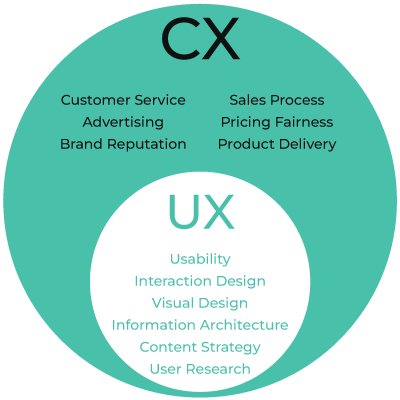Ever shop at a store where clothes are mixed together, you can’t find your size, and sales associates are out to lunch? Ever attempt to return a gift that isn’t your cup-of-tea only to be met with a Draconian policy that says no returns on odd-numbered days? Ever attempt to checkout from a website only to get an error — followed by a double charge on your credit card, and a full inbox error from customer support? Now, take a step back. In all of those cases, how likely are you to return to that store or site… and how loyal are you to their brand?
We’ll bet the answer is “unlikely, and not loyal at all.”
The Integral Role of Customer Service
Any good business craves creating positive, memorable experiences that encourage repeat business and brand loyalty. While marketing is often the front lines — introducing core values and messaging in the form of brand collateral, and communication (including your site, ads, etc.) — it’s the customer experience (aka CX) that has the power of persuasion.
CX is the sum total of the customer journey… from the time they are initially communicated with (be it in an ad, email, or just an organic search) until they’ve received and used their product or service. Woven into that journey is your customer service.

When businesses prioritize CX, they demonstrate a commitment to their customers’ satisfaction. This commitment translates into trust. Trust, in turn, leads to customer loyalty, positive word-of-mouth referrals, and ultimately, increased revenue. Trust is how you turn a customer into a fan.
Integrating Customer Experience into Your Marketing Strategy
Put simply, amazing CX should be one of your company’s core values. It should factor into your unique propositions. It deserves to be a brand feature — as much as any other bullet in your brand guide.
So, if you’re marrying CX to marketing, keep these ideas in mind:
1. Make Room in the Budget: Often, businesses allocate substantial budgets to marketing campaigns while neglecting the customer service department. By reallocating a portion of the marketing budget to enhance customer service, businesses can ensure that they are not only attracting customers but also retaining them.
2. Do Your Due Diligence: You don’t know what you don’t know. Put your CX to the test with a complete stem-to-stern audit. Understanding your customers’ journey and being open and honest to the good and the bad will help you augment your strategy for success.
3. Leverage Technology, but Never Forget the Human Element: In today’s digital age, technology plays a crucial role in customer service. Utilizing customer relationship management (CRM) systems, chatbots, and other automated tools can streamline processes, making it easier to provide quick and efficient service. However, it is essential to strike a balance between automation and human touch to maintain a personalized experience. When the technological solutions don’t appease your customer? Ensure you have a human-powered back-up system to keep your customer’s needs from falling through the cracks.
4. Listen, Learn, React, and Repeat: Customer feedback is a goldmine of insights. Regularly soliciting feedback through trusted sources (i.e. judge.me), surveys, reviews, and social media interactions helps identify areas for improvement. More importantly, acting on this feedback demonstrates a commitment to continuous improvement and customer satisfaction.
Going the Extra Mile
At ALX, we were founded on the concept: Lead with love. If you’re taking the lesson of CX to heart, perhaps now you’re thinking of your own brand. Here’s a few useful ideas to kickstart your new golden heart:
1. Get Personalized: Customers appreciate personalized experiences that cater to their individual needs and preferences. Using customer data to tailor interactions, recommendations, and offers can create a more engaging and satisfying experience.
2. Be Proactive: Anticipating customer needs and addressing potential issues before they arise can significantly enhance the customer experience. For example, notifying customers of delays or offering solutions to common problems proactively shows that the company cares about convenience.
3. Cache is King: In today’s omnichannel world, customers interact with businesses through various platforms, including social media, email, phone, and in-store visits. Ensuring a consistent and seamless experience across all these channels is vital for building trust and loyalty.
4. Make Memorable Moments: Small gestures can leave a lasting impression. Handwritten thank-you notes, surprise discounts, or personalized follow-up calls can make customers feel valued and appreciated. A memory made is a customer kept. Small gestures can leave a lasting impression. Handwritten thank-you notes, surprise discounts, or personalized follow-up calls can make customers feel valued and appreciated. A memory made is a customer kept.
The Competitive Advantage of Exceptional Customer Service
In a world where products and services are often similar, exceptional customer service can be a significant differentiator. Companies that prioritize customer service are more likely to build strong, long-term relationships with their customers. These relationships translate into repeat business, positive reviews, and referrals, all of which contribute to sustainable growth. A little investment goes a long way — and there’s no need to break the mold; just treat people the way you yourself would want to be treated.
A prime example: a recent purchase of a t-shirt from an online retailer went south when it arrived with a massive misprint. Within fifteen minutes of our notifying customer service (via a helpful live agent chat bot), a new shirt was ordered for us and we were asked to keep or ideally donate the shirt to a charity. When the new shirt arrived? We received a handwritten apology note along with a 10% off coupon for the hassle! Not only did we go back to the site to order, we wound up bookmarking it.
CX for Success
A great customer experience is not an optional add-on but a fundamental component of your overall brand value. Integrating into your marketing is a must. We suggest you start with an audit. Take your customer’s journey from stem to stern. Review it for consistency, expediency, and quality of communication. Then… take the opportunity to be honest with yourself. Improve based on your findings, and focus on building a sustainable system that places CX at the forefront — not just your bottom line.

